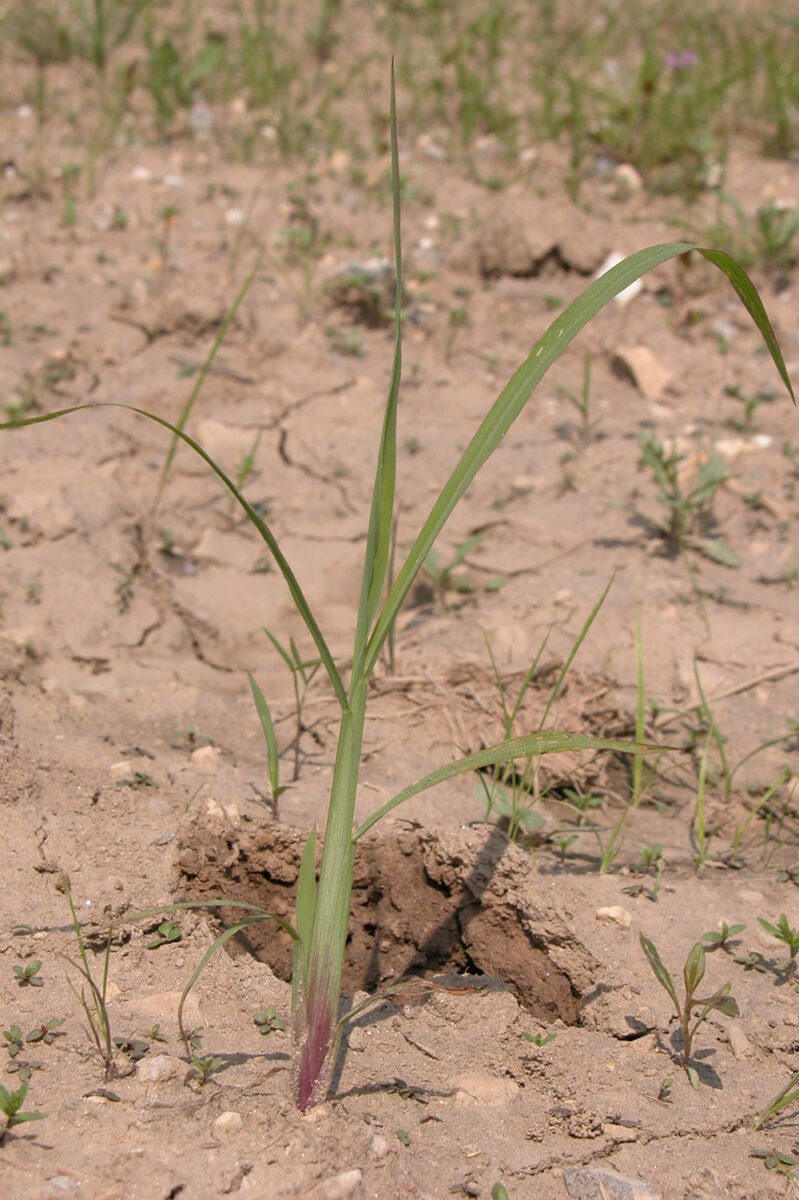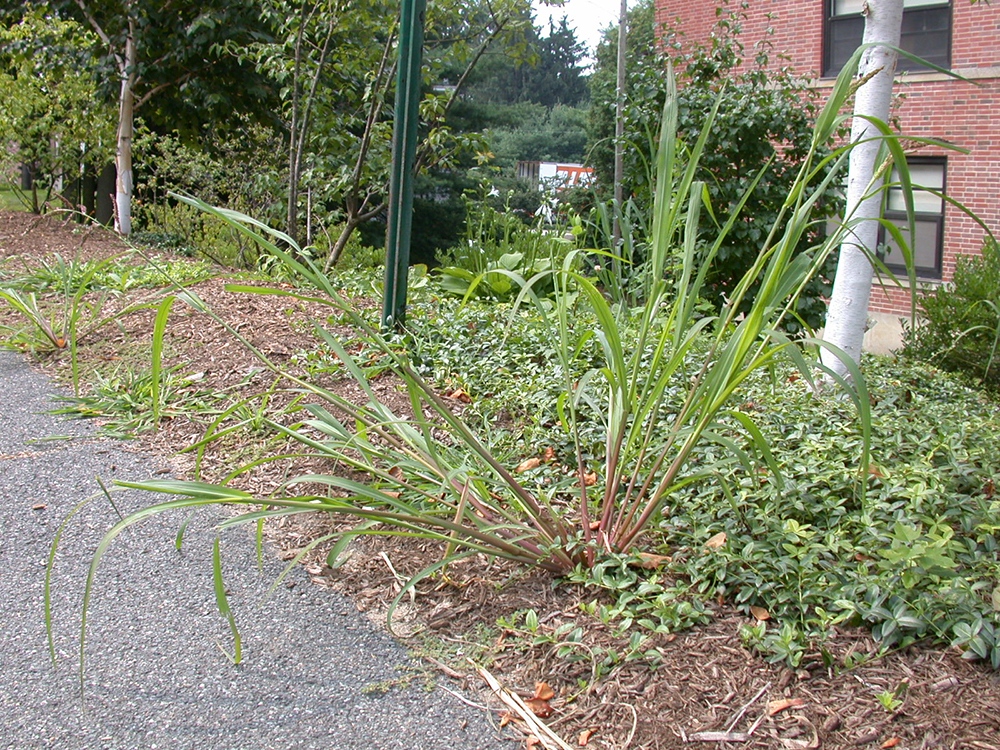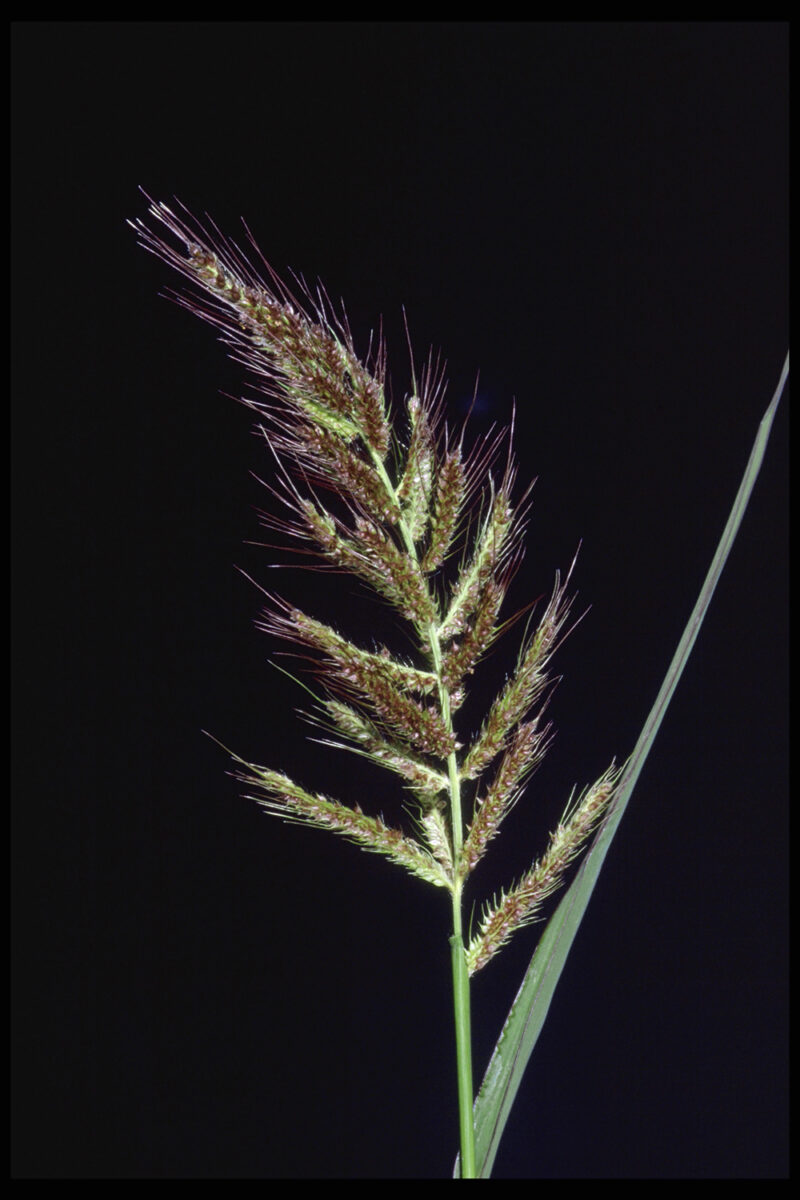Other common names: water grass, panic grass, cockspur grass, cocksfoot panicum, barn grass, summergrass, billion dollar grass, Japanese millet



Echinochloa crus-galli (L.) P. Beauv.
Identification of Barnyardgrass
Family: Grass family, Poacea
Habit: tall, upright, summer annual grass
Genus variability: The genus Echinochloa is composed of many distinct species and ecotypes that are difficult to classify. Two distinct clusters of weedy Echinochloa can be distinguished by molecular and structural markers, namely barnyardgrass (E. crus-galli) and late watergrass [E. oryzicola (Vasinger) Vasinger]. Both are found in North America; the former is a widespread weed found in many upland habitats whereas the latter, along with early watergrass [E. oryzoides (Ard.) Fritschis], are rice mimics that are found in permanently flooded rice fields in California. The watergrass species have larger seeds, less seed dormancy, shorter longevity in the soil and greater ability to emerge in deeply flooded fields. Junglerice [E. colona (L.) Link] is a predominant Echinochloa species in rice and other crops in Arkansas but requires several vegetative, reproductive and seed traits to distinguish from barnyardgrass. The discussion in this chapter pertains to E. crus-galli unless otherwise noted.
Description: The first leaf of the seedling is longer (2.5–5.5 inches) and more upright than most weedy annual grasses but shorter and more parallel to the soil surface than later leaves. All other leaves are vertical and rolled in the bud; thus, they uncurl as they come out of the stem to form a flat or slightly V-shaped surface. No ligules or auricles are present. Leaf blades are hairless and rough on the edges. Seedlings often feel “flat” when held. The stem may be reddish near the base. Mature plants have many tillers and grow in clumps. Plants can reach 5 feet in height. Near the base, stems may have a few hairs and may be red-purple in color. Sheaths are split open near the top so that the underlying sheath of the next leaf is visible. The collar region is white, wide, hairless and with no ligule or auricle. Leaf blades are 4–8 inches long by 0.13–0.75 inch wide and have a prominent midvein. Barnyardgrass has a fibrous root system and can grow new roots where tillers touch the ground. The inflorescence is a green to purple, lumpy panicle. Short stalks are widely spaced along the stems, although this feature can vary. Seeds are teardrop shaped, brown-gray and flat on one side, measuring about 0.13 inch in size. As with other grasses, the apparent seed includes a thin, tightly adhering layer of fruit tissue. Seeds have ridges along their length, and the attached chaff has awns of 0.13–0.5 inch.
Similar species: Aside from the similar Echinochloa species discussed above, similar species occur in other genera. Fall panicum (Panicum dichotomiflorum Michx.) can be confused with barnyardgrass, but fall panicum has a ligule and coarser foliage than barnyardgrass. Yellow foxtail [Setaria pumila (Poir.) Roem. & Schult.] has a similar growth habit and red stem bases, but it has a hairy ligule and a somewhat soft inflorescence that resembles a bottlebrush or a fox’s tail.
Management of Barnyardgrass
Since the seeds are only moderately persistent, rotation with perennial forage crops can help reduce density of barnyardgrass. Because barnyardgrass germinates in warm soil, winter grains or grain crops planted in early spring will be highly competitive by the time the weed emerges. Also, shade by the crop will cool the soil and reduce further germination. For summer planted crops, a lag of two weeks or more between tillage and seedbed preparation will destroy many seedlings, provided the soil is warm and moist.
For crops planted in late spring and summer, cultivate frequently and close to the row to control this fast growing weed. Although timely tine weeding or rotary hoeing can greatly reduce the population, some individuals in the row will emerge from deeper than these implements can safely reach. Barnyardgrass may re-emerge following shallow burial but not if completely buried by 1.6 inches or more of soil. Therefore, hill up soil in the crop row to the fullest extent that the crop will tolerate.
Organic mulch placed early will keep the soil cool and suppress germination, but some barnyardgrass may emerge anyway. Mulch placed after the soil warms must be exceptionally dense or thick to be effective. Dense planting of summer cover crops or cash crops that will tolerate high density helps control this shade-intolerant weed.
Removing escapes before plants set seeds is useful for long-term control in intensively managed vegetable systems. Promptly cleaning up fields after harvest of small grains and vegetables is similarly helpful. In a pair of experiments in Arkansas, 41% of seeds were still on the plant at soybean harvest, indicating that a substantial proportion of seeds could be captured or destroyed during combine harvesting.
Since the seeds do not tolerate high soil temperatures when moist, solarization with clear plastic for 40 days kills barnyardgrass seeds in the top 1.2 inch of soil and reduces seed density deeper in the soil.
Ecology of Barnyardgrass
Origin and distribution: Barnyardgrass is native to South Asia and Europe. It ranges around the world from 50° N to 40° S latitude, except for tropical Africa. It occurs across southern Canada and in all states except Alaska.
Seed weight: Mean seed weight of 10 populations varied from 1.7–2.1 mg, with most near the lower end of the range.
Dormancy and germination: Seeds are dormant when shed from the parent plant. Three to eight months of either dry or moist after-ripening will break dormancy. Barnyardgrass seeds undergo an innate annual dormancy cycle that is not induced by soil conditions, with germinability reaching a peak in May–July and falling to near zero germinability in September–November. If the seeds are moist, alternate freezing and thawing for four days breaks dormancy of over 65% of seeds. Two weeks at 40°F or soaking for four days will each break dormancy of over 30% of seeds. Seeds of barnyardgrass will germinate from 60–100°F, with the optimum temperature for germination varying among populations in the range 77–100°F. Exposure to small amounts of light promotes germination of some seeds, especially after burial over the winter, but several days of exposure may be required for full effect. Temperature of 115°F for as little as half an hour removes the light requirement of most seeds. Nitrate only induces a small increase in percentage germination. Unlike most agricultural weeds, barnyardgrass will germinate in completely anaerobic conditions and when fully immersed in water.
Seed longevity: Barnyardgrass seeds can retain high viability for at least three years when buried in the soil, and a few seeds can persist for up to 13 years. One study, however, found less than 6% of seeds survived for six months. Another found approximately 37–42% mortality after one year but with extreme variation in subsequent seed survival among replicates. Thus, local conditions can have a large effect on seed survival. Most seeds near the soil surface that do not emerge will lose viability within one year.
Season of emergence: Barnyardgrass begins emerging in mid-spring, reaches peak emergence in late spring or early summer, and a few plants continue to emerge until late summer or early fall. In California, barnyardgrass emergence is more closely associated with irrigation than with season.
Emergence depth: Seedlings emerge best from the top 1 inch, but substantial emergence occurs from 1–2 inches. Seedlings rarely emerge from deeper than 3 inches. One report indicated poor emergence from seeds on the soil surface and best emergence began from the 0.5-inch depth. In flooded conditions, emergence is from the top 0.8 inch.
Photosynthetic pathway: C4
Sensitivity to frost: The species is frost sensitive.
Drought tolerance: Growth of young barnyardgrass is reduced more by dry soil than many other weed species and is about as drought tolerant as corn. Roots of well-developed plants reach to more than 40-inch soil depths, which allows them to tap deep soil moisture during dry periods.
Mycorrhiza: Barnyardgrass is mycorrhizal.
Response to fertility: Barnyardgrass is highly responsive to nitrogen fertility, with plant size increasing rapidly with N application rates up to 143 pounds per acre. Its growth response to increasing P is relatively flat compared to other weeds and crops, but it continues to increase in size up to application rates of 122 pounds per acre of P2O5. It can take up and concentrate phosphorus at the expense of crops. In Arkansas field margins, it occurred most frequently in soils of pH 6.4–6.8.
Soil physical requirements: Barnyardgrass does best on soils that hold water well but can tolerate soil textures as coarse as loamy sands. The species is highly tolerant of waterlogged and flooded soils, and is one of the worst weeds of rice paddies. Soils with relatively large waterholding capacity and high fertility provide an ideal substrate for this species. It is moderately tolerant of salinity and suffers less than rice in saline conditions.
Response to shade: Barnyardgrass tolerates 50% shade well. Plant weight, but not height, is greatly reduced by shade of 73% or more.
Sensitivity to disturbance: Some seedlings will re-emerge following complete burial, provided the soil remains moist. The fibrous root system of medium to large plants makes them difficult to fully uproot with hoes or cultivators. Barnyardgrass regrows readily after clipping.
Time from emergence to maturation: Plants take longer to mature and produce more seeds when they emerge in spring when day-length is increasing but mature sooner and produce fewer seeds when they emerge in summer when day-length is decreasing. Also, plants grow most rapidly at temperatures of about 95°F in the day and 77°F at night but mature more slowly than when temperatures are warmer or cooler. Plants typically flower five to eight weeks after emergence, with late emerging plants flowering most quickly; but very late emerging plants (September) are also slow to flower. A few seeds may become viable at the milk-soft dough stage as early as five days after flowering. Most seeds are viable by three weeks after flowering.
Pollination: Barnyardgrass is primarily self pollinated, but some wind mediated cross-pollination also occurs. Late in the season, flowers may self-pollinate while still wrapped in the sheath.
Reproduction: A large plant may produce over 100,000 seeds, whereas a highly stressed individual may produce less than 10. More typically, seed production is several thousand to several tens of thousands of seeds per plant, but seed production of over 200,000 per plant has been observed in a California sugar beet field. The intensity of competition from the crop greatly affects seed production. For example, plants emerging with corn produced 11,200 seeds per plant, whereas those emerging at the four-leaf stage produced only 200 seeds per plant. Other studies have shown similar large reductions in seed production for plants emerging after the crop.
Dispersal: Barnyardgrass has no inherent dispersal mechanism, and seeds become scattered around the mother plant. As a weed, the primary dispersal mechanism is on farming equipment or in crop seeds. The seeds are a common contaminant of crop seed, manure and cotton gin waste, and can be dispersed when these materials are used to fertilize fields. Barnyardgrass seeds can float for several days and disperse in irrigation water, and probably also in flood water. Seeds are dispersed by ducks and other birds, and by the awns sticking to animal fur.
Common natural enemies: A weevil, Hyperodes humilus, has been reported to attack the growing point of barnyardgrass in Massachusetts and kill young plants, but generally, this weed has no important natural enemies.
Palatability: The seeds are edible, and the plant is generally a good forage for livestock. Japanese millet (E. frumentacea Link) is a cultivated variety of barnyardgrass that is grown for grain in tropical Asia and Africa, and is used as a fast growing forage and cover crop in the United States. Under highly fertile conditions, nitrate may accumulate to levels that are toxic to livestock.
Summary Table of Barnyardgrass Characteristics
| Barnyardgrass | ||||||||
|---|---|---|---|---|---|---|---|---|
| Growth habit | Seed weight (mg) | Seed dormancy at shedding | Factors breaking dormancy | Optimum temperature for germination (F) | Seed mortality in untilled soil (%/year) | Seed mortality in tilled soil (%/year) | Typical emergence season | Optimum emergence depth (inches) |
| tall | 1.7–2.1 | Yes | cms, li | 77–100 | 37–42 | na | mid-spring to early summer | 0.5–2 |
| Photosynthesis type | Frost tolerance | Drought tolerance | Mycorrhiza | Response to nutrients | Emergence to flowering (weeks) | Flowering to viable seed (weeks) | Pollination | Typical & high seed production (seeds per plant) |
| C4 | low | low | yes | high | 5–8 | 3 | self, can cross | 10,000 & 100,000 |
Table Key
General: The designation “–” signifies that data is not available or the category is not applicable.
Growth habit: A two-word description; the first word indicates relative height (tall, medium, short, prostrate) and second word indicates degree of branching (erect, branching, vining).
Seed weight: Range of reported values in units of “mg per seed.”
Seed dormancy at shedding: “Yes” if most seeds are dormant when shed, “Variable” if dormancy is highly variable, “No” if most seeds are not dormant.
Factors breaking dormancy: The principle factors that are reported to break dormancy and facilitate germination. The order of listing does not imply order of importance. Abbreviations are:
scd = seed coat deterioration
cms = a period subjected to cold, moist soil conditions
wst = warm soil temperatures
li = light
at = alternating day-night temperatures
ni = nitrates
Optimum temperature range for germination: Temperature (Fahrenheit) range that provides for optimum germination of non-dormant seeds. Germination at lower percentages can occur outside of this range. The dash refers to temperature range, and the slash refers to alternating day/night temperature amplitudes.
Seed mortality in untilled soil: Range of mortality estimates (percentage of seed mortality in one year) for buried seeds in untilled soil. Values were chosen where possible for seeds placed at depths below the emergence depth for the species and left undisturbed until assessment. Mortality primarily represents seed deterioration in soil.
Seed mortality in tilled soil: Range of mortality estimates (percentage of seed mortality in one year) for seeds in tilled soil. Values were chosen for seeds placed within the tillage depth and subjected to at least annual tillage events. Seed losses are the result of dormancy-breaking cues induced by tillage, germination and deterioration of un-germinated seeds.
Typical emergence season: Time of year when most emergence occurs in the typical regions of occurrence for each weed. Some emergence may occur outside of this range.
Optimum emergence depth: Soil depths (in inches below the soil surface) from which most seedlings emerge. Lower rates of emergence usually will occur at depths just above or just below this range.
Photosynthesis type: Codes “C3” or “C4” refer to the metabolic pathway for fixing carbon dioxide during photosynthesis. Generally, C3 plants function better in cooler seasons or environments and C4 plants function better in warmer seasons or environments.
Frost tolerance: Relative tolerance of plants to freezing temperatures (high, moderate, low).
Drought tolerance: Relative tolerance of plants to drought (high, moderate, low).
Mycorrhiza: Presence of mycorrhizal fungi. “Yes” if present; “no” if documented not to be present, “unclear” if there are reports of both presence and absence; “variable” if the weed can function either with or without, depending on the soil environment.
Response to nutrients: Relative plant growth response to the nutrient content of soil, primarily N, P, K (high, moderate, low).
Emergence to flowering: Length of time (weeks) after emergence for plants to begin flowering given typical emergence in the region of occurrence. For species emerging in fall, “emergence to flowering” means time from resumption of growth in spring to first flowering.
Flowering to viable seed: Length of time (weeks) after flowering for seeds to become viable.
Pollination: “Self” refers to species that exclusively self-pollinate, “cross” refers to species that exclusively cross-pollinate, “self, can cross” refer to species that primarily self-pollinate, but also cross-pollinate at a low rate, and “both” refers to species that both self-pollinate and cross-pollinate at relatively similar rates.
Typical and high seed production potential: The first value is seed production (seeds per plant) under typical conditions with crop and weed competition. The second value, high seed production, refers to conditions of low density without crop competition. Numbers are rounded off to a magnitude that is representative of often highly variable reported values.
Further Reading
Holm, L.G., D.L. Plucknett, J.V. Pancho and J.P. Herberger. 1977. The World's Worst Weeds: Distribution and Biology. The University Press of Hawaii: Honolulu.
Maun, M.A. and S.C.H. Barrett. 1986. The biology of Canadian weeds. 77. Echinochloa crus-galli (L.) Beauv. Canadian Journal of Plant Science 66: 739–759.
Norris, R.F. 1992. Case history for weed competition/population ecology: barnyardgrass (Echinochloa crus-galli) in sugar beets (Beta vulgaris). Weed Technology 6: 220–227.
Vengris, J., M.E.R. Hill and D.L. Field. 1966. Clipping and regrowth of barnyardgrass. Crop Science 6: 342–344.

